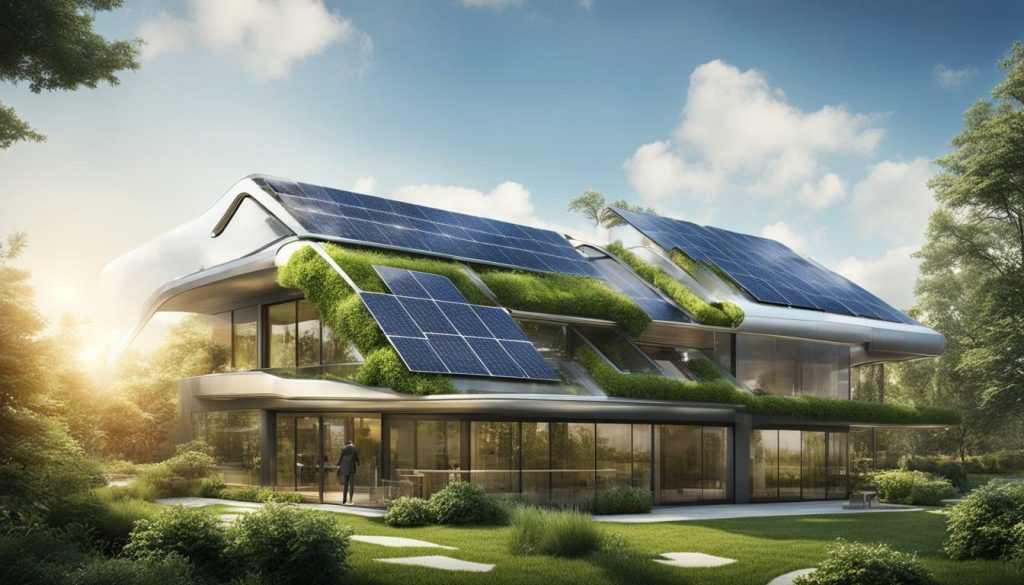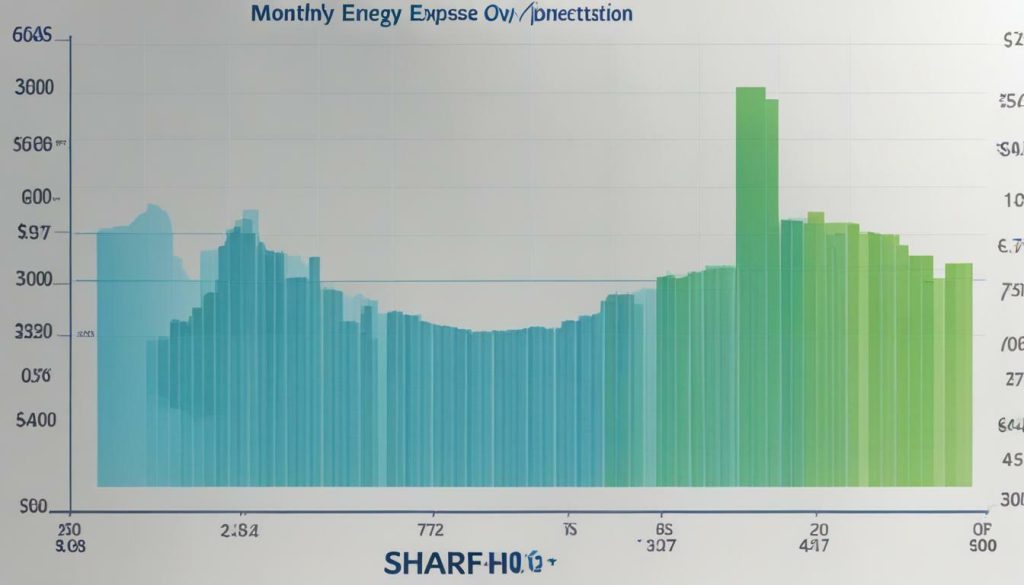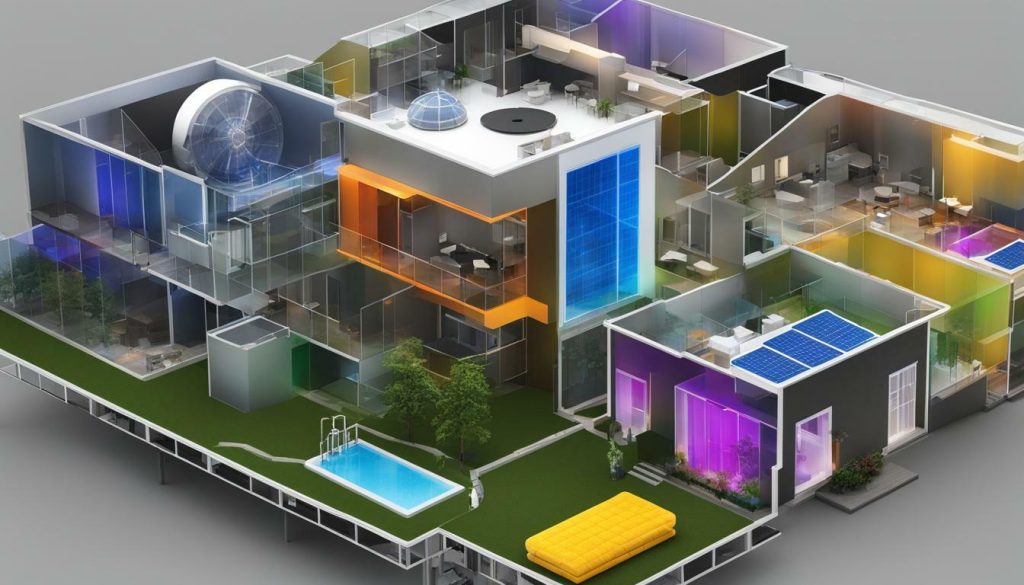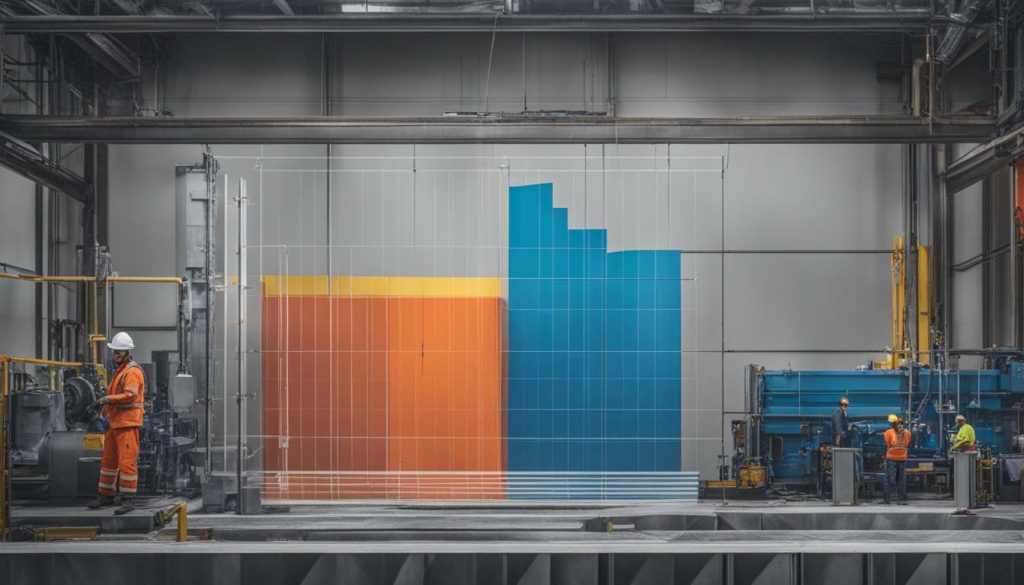Tracking the progress of your HVAC installation and retrofit projects is essential for ensuring efficiency and timely completion. To manage these projects effectively, it is crucial to have a clear purpose in mind, understand local building codes, explore alternative upgrades, consider maintenance costs, embrace new technology, hire an experienced contractor, utilize tools and resources, conduct financial analysis, and implement measurement and verification strategies.
Key Takeaways:
- Having a clear purpose for the retrofit project, such as reducing energy costs or expanding capacity, is crucial.
- Understanding and complying with local building codes is essential, especially for exterior modifications in historic districts.
- Exploring alternative HVAC upgrades, such as mini-duct or ductless systems, can be beneficial if the existing ductwork is insufficient.
- Considering long-term maintenance costs and the potential benefits of replacing older HVAC components during the retrofit is important.
- Embracing new technology can significantly impact energy efficiency and overall project performance.
Understanding the Purpose and Scope of the Retrofit Project
Defining the purpose and scope of your HVAC retrofit project is the first step towards successful tracking and management. Whether your goal is to reduce energy costs or expand the capacity of your HVAC system, having a clear understanding of the project’s objectives is crucial for effective planning and execution.
Consider the specific goals you want to achieve through the retrofit. Are you looking to improve energy efficiency and reduce monthly expenses? Or perhaps you need to upgrade your system to handle increased demand or provide better comfort for occupants. By identifying these goals, you can tailor your project to meet your specific needs.
It is also important to consider the local building codes and regulations that may affect your retrofit project. In historic districts or areas with specific restrictions, there may be limitations on exterior modifications. By familiarizing yourself with these codes, you can ensure compliance and avoid any delays or legal issues during the project.
| Key Considerations for HVAC Retrofit Projects |
|---|
| Define the purpose and goals of the retrofit |
| Consider local building codes and restrictions |
| Identify alternative upgrades if needed |
| Evaluate maintenance costs and consider component replacement |
| Explore new technology for energy efficiency |
| Hire an experienced contractor |
| Utilize tools and resources for design and analysis |
| Conduct a thorough financial analysis |
| Implement measurement and verification strategies |
By following these guidelines and considering these key factors, you can set the foundation for a successful HVAC retrofit project. In the next section, we will explore alternative upgrades that can be considered when the existing ductwork is not sufficient for the retrofit.

Familiarizing Yourself with Local Building Codes
Ensuring compliance with local building codes is crucial for a seamless HVAC retrofit project. Understanding these codes and regulations will help you avoid potential setbacks and ensure that your project meets all the necessary requirements.
When it comes to exterior modifications, especially in historic districts, local building codes may have specific restrictions in place to preserve the architectural integrity of the area. These restrictions can include limitations on the types of materials used, the height and size of the structure, and even the color of the building. It is essential to familiarize yourself with these regulations to prevent any violations that may result in fines or delays in your project.
By following local building codes, you can ensure that your HVAC retrofit project is not only compliant but also meets the safety standards and guidelines set by the authorities. This will not only give you peace of mind but also help maintain the value of your property in the long run.
Table 1: Examples of Local Building Code Restrictions
| Restriction | Historic District | Residential Area |
|---|---|---|
| Height Limitations | 2 stories | 3 stories |
| Exterior Material | Brick or stone | Brick, stone, or siding |
| Color Restrictions | Neutral tones | No restrictions |
Table 1 provides examples of local building code restrictions that may be applicable in a historic district and a residential area. It is essential to consult with local authorities or building code officials to determine the specific regulations for your location.

Familiarizing yourself with local building codes and adhering to them will not only ensure the successful completion of your HVAC retrofit project, but it will also help you avoid any potential legal and financial consequences that may arise from non-compliance.
Exploring Alternative HVAC Upgrades
Considering alternative HVAC upgrades can optimize the performance and efficiency of your retrofit project. When the existing ductwork is not sufficient, exploring options like mini-duct or ductless systems can provide a reliable solution. These alternative upgrades offer several benefits, including improved energy efficiency and easier installation.
Mini-duct systems utilize smaller, flexible ducts that can be easily installed in tight spaces or retrofitted into older buildings. The smaller diameter of the ducts results in less energy lost during air distribution, leading to increased overall system efficiency. Additionally, mini-duct systems offer zoning capabilities, allowing for better control over the temperature in different areas of your building.
On the other hand, ductless systems eliminate the need for ductwork altogether. These systems consist of a small outdoor unit and individual indoor units installed in each room. Ductless systems offer flexible zoning and temperature control, as well as easy installation and minimal disruption to your existing space. They are an ideal solution for retrofit projects where traditional ductwork installation is not feasible or cost-effective.

| Alternative HVAC Upgrades | Benefits |
|---|---|
| Mini-duct systems |
|
| Ductless systems |
|
Considering Maintenance Costs and Component Replacement
Taking maintenance costs into account is essential for long-term cost-effectiveness in HVAC retrofit projects. While the initial installation and retrofit may require a significant investment, it is equally important to consider the ongoing maintenance expenses. Regular maintenance ensures the efficient operation of the HVAC system and prevents costly breakdowns or premature component failures.
One approach to minimize maintenance costs is to replace older HVAC components during the retrofit. Aging components are more prone to failure and may be less energy efficient compared to newer models. By upgrading these components, businesses can improve system performance, reduce maintenance requirements, and lower energy consumption.

In some cases, it may be beneficial to consider a comprehensive maintenance plan that includes regular inspections, cleanings, and filter replacements. This proactive approach helps identify potential issues before they escalate and ensures optimal system performance. Additionally, businesses should schedule routine HVAC system tune-ups to identify and address any emerging maintenance needs.
By considering maintenance costs and prioritizing component replacement as part of the HVAC retrofit project, businesses can achieve long-term cost-effectiveness and maximize the performance and lifespan of their HVAC systems.
Embracing New Technology for Energy Efficiency
Embracing cutting-edge technology can enhance energy efficiency in your HVAC retrofit project. As advancements continue to revolutionize the industry, incorporating new technology into your project can lead to significant reductions in monthly energy expenses while improving overall performance.
One example of innovative technology is the use of smart thermostats. These devices enable you to control your HVAC system remotely and adjust temperature settings based on occupancy patterns and weather conditions. By optimizing energy usage, smart thermostats can help you save on utility bills while maintaining a comfortable indoor environment.
Another key technology to consider is variable refrigerant flow (VRF) systems. VRF systems use advanced heat transfer techniques to efficiently cool or heat different areas of a building individually. By allowing for precise temperature control in different zones, VRF systems can significantly reduce energy waste and costs, especially in large or multi-story buildings.
To visualize and analyze the energy efficiency of your HVAC retrofit project, energy modeling software can be an invaluable tool. This software can simulate various scenarios to determine the most effective design and optimization strategies for your project. By identifying potential inefficiencies and recommending improvements, energy modeling software can help you make informed decisions and achieve optimal energy savings.
| Benefits of Embracing New Technology: |
|---|
| 1. Reduced monthly energy expenses |
| 2. Enhanced control and customization of HVAC systems |
| 3. Improved energy efficiency and sustainability |
| 4. Potential eligibility for energy efficiency incentives and rebates |

Take advantage of new technology to maximize energy efficiency in your HVAC retrofit project:
- Install smart thermostats for remote control and optimized temperature settings.
- Consider the implementation of variable refrigerant flow (VRF) systems for individual zone control.
- Utilize energy modeling software to visualize and analyze energy efficiency scenarios.
By embracing new technology, you can achieve significant energy savings and create a more sustainable and comfortable environment within your retrofit project. Remember to consult with industry professionals to determine the best technology solutions that align with your goals and budget.
The Importance of Hiring an Experienced Contractor
Choosing an experienced contractor is vital to the smooth execution of your HVAC retrofit project. An experienced contractor brings a wealth of knowledge and expertise to the table, ensuring that your project complies with local building codes and regulations. They possess a deep understanding of the unique challenges and requirements associated with HVAC retrofits, allowing them to navigate potential obstacles with ease.
By hiring an experienced contractor, you can have peace of mind knowing that your project will be completed successfully. They have a proven track record of delivering high-quality workmanship and meeting project deadlines. With their extensive network of industry contacts, they can also help source high-quality materials and equipment for your retrofit, ensuring optimal performance and longevity.
Moreover, an experienced contractor can provide valuable insights and recommendations throughout the project. They can help you make informed decisions about alternative HVAC upgrades, such as mini-duct or ductless systems, that may be more suitable for your specific needs. They can also offer guidance on maintenance costs and component replacement, helping you optimize the long-term efficiency and durability of your HVAC system.
The Benefits of Hiring an Experienced Contractor
When it comes to HVAC retrofit projects, an experienced contractor is an invaluable asset. Their expertise and industry knowledge contribute to the successful completion of your project, ensuring that it aligns with building codes and regulations. By entrusting your retrofit to an experienced contractor, you can rest assured that your project is in capable hands.
Utilizing Tools and Resources for Design and Analysis
Utilizing tools and resources can streamline the design and analysis process of your HVAC retrofit project. Energy modeling software, in particular, is a valuable tool that can help you optimize the efficiency and performance of your retrofit. With energy modeling software, you can simulate different scenarios and make informed decisions about your HVAC system design.
An energy model allows you to input various parameters such as building size, insulation levels, and equipment specifications, and analyze how different design options will impact energy consumption, indoor comfort, and overall system performance. By using this software, you can evaluate the energy efficiency of different HVAC system configurations and select the most suitable one for your project.
In addition to energy modeling software, there are other tools and resources available that can aid in the design and analysis of HVAC retrofit projects. These resources may include design guides, technical manuals, and online calculators. These tools can provide valuable information and guidelines to ensure that your retrofit meets the necessary standards and regulations.

By utilizing tools and resources during the design and analysis phase, you can make informed decisions that will optimize the energy efficiency and performance of your HVAC retrofit project. These tools can help you save time, reduce costs, and ensure that your project meets the desired goals and objectives.
Financial Analysis and Building Efficiency Financing
Performing a comprehensive financial analysis is crucial for the successful implementation of your HVAC retrofit project. This analysis enables you to assess the financial feasibility of the project, identify potential savings, and make informed decisions regarding building efficiency financing.
One aspect of financial analysis is determining the payback period for the retrofit project. This calculation involves comparing the upfront costs of the project with the expected savings over time. By analyzing the payback period, you can evaluate the project’s financial viability and determine the most cost-effective strategies for improving energy efficiency.
Another important consideration in financial analysis is available financing mechanisms for building efficiency projects. These mechanisms can help offset the initial costs and provide financial incentives for implementing energy-efficient solutions. Examples of financing mechanisms include utility rebates, grants, low-interest loans, and performance-based contracts. By exploring these options, you can identify the most suitable financing strategy for your HVAC retrofit project.
| Financing Mechanism | Description | Benefits |
|---|---|---|
| Utility Rebates | A refund offered by utility companies for implementing energy-efficient measures. | Reduces the upfront costs of the retrofit and provides immediate financial incentive. |
| Grants | Funding provided by government agencies or non-profit organizations for energy efficiency projects. | Can cover a significant portion of the project costs and reduce financial burden. |
| Low-Interest Loans | Loans with below-market interest rates available for energy efficiency upgrades. | Enables financing the project while minimizing long-term interest expenses. |
| Performance-Based Contracts | Agreements where a third-party provider guarantees energy savings and covers the project costs. | Shifts the financial risk to the provider, allowing the organization to focus on the retrofit’s benefits. |
Table: Financing Mechanisms for Building Efficiency Projects
By conducting a thorough financial analysis and taking advantage of available financing mechanisms, you can improve the financial viability of your HVAC retrofit project and accelerate the return on investment. Remember to consult with financial experts and explore local incentives to maximize the financial benefits of your energy efficiency upgrades.

Implementing Measurement and Verification Strategies
Implementing measurement and verification strategies is essential for evaluating the effectiveness of your HVAC retrofit project. By tracking and measuring the impact of the retrofit on energy efficiency, you can ensure that the project is meeting its goals and identify areas for improvement. Measurement and verification allow you to assess the performance of your HVAC system, validate energy savings, and make informed decisions about future upgrades and maintenance.
There are several key strategies and tools that can help you effectively measure and verify the success of your retrofit project. One such strategy is the use of energy meters, which provide real-time data on energy consumption and allow you to monitor the performance of your HVAC system. Additionally, building automation systems can provide valuable insights into energy usage patterns and identify areas where improvements can be made.
Another important aspect of measurement and verification is the establishment of key performance indicators (KPIs) for your project. These KPIs can include metrics such as energy savings, reduction in greenhouse gas emissions, or improvement in indoor air quality. By setting clear goals and tracking your progress against these indicators, you can ensure that your retrofit project is on track and delivering the expected results.
| Benefits of Implementing Measurement and Verification Strategies | Examples |
|---|---|
| Assess the energy performance of your HVAC system | Monitoring energy consumption in real-time |
| Validate energy savings and return on investment | Comparing pre-retrofit and post-retrofit energy usage |
| Identify opportunities for further energy efficiency improvements | Identifying areas where energy usage can be optimized |
In conclusion, implementing measurement and verification strategies is vital for evaluating the effectiveness of your HVAC retrofit project. By utilizing energy meters, building automation systems, and establishing key performance indicators, you can track and measure the impact of your retrofit on energy efficiency. This allows you to make informed decisions about future upgrades, ensure the success of your project, and ultimately achieve your energy-saving goals.

HVAC Project Tracking Tools and Solutions
Utilizing HVAC project tracking tools and solutions can enhance the efficiency and organization of your HVAC projects. With the right software and technologies, you can streamline project management, improve communication, and ensure timely completion of tasks. Here are some top HVAC project tracking tools and solutions to consider:
- Project Management Software: These comprehensive solutions offer features like task management, scheduling, document sharing, and real-time collaboration. They allow you to track project progress, allocate resources efficiently, and keep all stakeholders informed.
- HVAC Tracking Software: Specifically designed for HVAC projects, this software provides functionalities tailored to the unique needs of the industry. It can help track equipment installation, monitor energy consumption, and generate reports for analysis.
- Energy Modeling Software: These tools enable you to simulate and analyze the energy performance of your HVAC system. By inputting relevant data, you can identify potential areas for improvement and make informed decisions about upgrades and replacements.
Additionally, integrating mobile apps into your project tracking process can offer flexibility and convenience. Mobile apps allow project managers and technicians to access project information, update task statuses, and communicate in real-time, even when on-site.
By implementing these HVAC project tracking tools and solutions, you can optimize your project management processes, improve productivity, and achieve successful outcomes. Streamlined tracking and efficient communication will help you stay on top of your HVAC installation and retrofit projects, ensuring timely completion and client satisfaction.
Table: Popular HVAC Project Tracking Tools and Solutions
| Tool/Solution | Description |
|---|---|
| Project Management Software | Comprehensive software for task management, scheduling, and collaboration. |
| HVAC Tracking Software | Specialized software for tracking HVAC equipment installation and energy consumption. |
| Energy Modeling Software | Software for simulating and analyzing the energy performance of HVAC systems. |
![]()
In summary, implementing the right HVAC project tracking tools and solutions can greatly improve the management of your HVAC installation and retrofit projects. From project management software to specialized HVAC tracking software and energy modeling tools, you have various options to choose from. By leveraging these tools and technologies, you can enhance efficiency, reduce errors, and achieve successful project outcomes.
Conclusion
Tracking HVAC projects is a vital aspect of effective project management, leading to successful outcomes. When embarking on an HVAC retrofit project, it is important to have a clear purpose in mind. Whether your goal is to reduce energy costs or expand the capacity of the HVAC system, having a defined purpose will help guide the project and ensure its success.
Understanding the local building codes is another crucial factor to consider. Compliance with these codes is essential, especially when it comes to exterior modifications in historic districts or areas with specific restrictions. By adhering to the local regulations, you can avoid costly and time-consuming setbacks.
Exploring alternative HVAC upgrades can also be beneficial. If the existing ductwork is not sufficient for the retrofit, considering options like mini-duct or ductless systems can provide energy efficiency and ease of installation. Additionally, it is important to take maintenance costs into account. Evaluating the long-term expenses and considering the replacement of older HVAC components during the retrofit can lead to cost savings in the future.
Embracing new technology is another way to improve the efficiency and performance of the HVAC retrofit. Advanced technology solutions can help reduce monthly energy expenses and optimize the overall system performance. Hiring an experienced contractor who is knowledgeable about building codes and can deliver high-quality workmanship is crucial for the successful completion of your project.
Utilizing tools and resources such as energy modeling software can aid in the design and analysis of the HVAC retrofit. These valuable resources can help optimize the efficiency and performance of the project, ensuring its success. Conducting a thorough financial analysis and exploring building efficiency financing options will also contribute to the smooth implementation of the retrofit.
Lastly, implementing measurement and verification strategies is necessary to assess the effectiveness of the HVAC retrofit. By tracking and measuring the impact of the retrofit on energy efficiency, you can ensure that your project is meeting its intended objectives.
By considering these key factors and utilizing project tracking tools, you can streamline the management of your HVAC projects and achieve efficient, cost-effective, and timely completion.
FAQ
What factors should I consider when tracking HVAC installation and retrofit project progress?
When tracking HVAC projects, it is important to consider the purpose of the retrofit, local building codes, alternative HVAC upgrades, maintenance costs, new technology, the importance of hiring an experienced contractor, utilizing tools and resources, conducting financial analysis, implementing measurement and verification strategies, and using HVAC project tracking tools and solutions.
What should I consider when determining the purpose and scope of an HVAC retrofit project?
Before starting an HVAC retrofit project, it is crucial to have a clear understanding of its purpose and scope. Consider goals such as reducing energy costs or expanding the capacity of the HVAC system.
Why is it important to familiarize myself with local building codes?
Local building codes play a significant role in HVAC retrofit projects. It is essential to understand and comply with these codes, especially regarding exterior modifications in historic districts and areas with specific restrictions.
Are there any alternative HVAC upgrades I should consider?
If the existing ductwork is not sufficient for the retrofit, explore alternative upgrades such as mini-duct or ductless systems. These options offer energy efficiency and ease of installation.
Should I take maintenance costs and component replacement into account?
Yes, in addition to the installation and retrofit costs, it is important to consider the long-term maintenance expenses. Evaluate maintenance costs and consider replacing older HVAC components during the retrofit for potential benefits.
How can embracing new technology help with energy efficiency?
New technology can significantly impact the energy efficiency of your HVAC system. Explore advanced technology options that can reduce monthly energy expenses and enhance the overall performance of the retrofit project.
Why is hiring an experienced contractor important?
Hiring an experienced contractor is crucial for the successful completion of HVAC retrofit projects. They ensure compliance with building codes and deliver high-quality workmanship.
What tools and resources can aid in HVAC retrofit design and analysis?
Utilize energy modeling software and other valuable resources to assist in the design and analysis of HVAC retrofit projects. These tools can optimize efficiency and performance.
Why is financial analysis important for HVAC retrofit projects?
Conducting a thorough financial analysis is crucial for HVAC retrofit projects. It helps identify building efficiency financing options and specific financing mechanisms that align with your project goals.
How can measurement and verification strategies benefit HVAC retrofit projects?
Measurement and verification strategies assess the effectiveness of HVAC retrofit projects. These strategies track and measure the impact on energy efficiency, ensuring the project’s success.
What HVAC project tracking tools and solutions are available?
There are various project tracking tools and software specifically designed for HVAC projects. These solutions streamline project management processes and help businesses effectively track their HVAC projects.




0 Comments